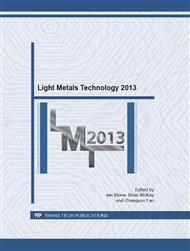p.321
p.326
p.331
p.336
p.343
p.348
p.353
p.358
p.363
FEA Modelling of Cutting Force and Chip Formation in Thermally Assisted Machining of Ti6Al4V Alloy
Abstract:
The improvement of machinability during thermally assisted turning of Ti-6Al-4V alloy was investigated by finite element modelling. A 2D thermally assisted turning model was developed and validated by comparing the simulation results with experimental results. Detailed analyses were carried out on the simulations in terms of the influence of the initial work-piece temperature on cutting forces and chip formation in the TAM process. The predicted cutting forces showed a very good correlation to the experimental results, and both the simulation and experiments have proved that the initial work-piece temperature plays an important role in determining the cutting force, with increasing initial temperature reducing the cutting force.
Info:
Periodical:
Pages:
343-347
Citation:
Online since:
July 2013
Authors:
Keywords:
Price:
Сopyright:
© 2013 Trans Tech Publications Ltd. All Rights Reserved
Share:
Citation:


